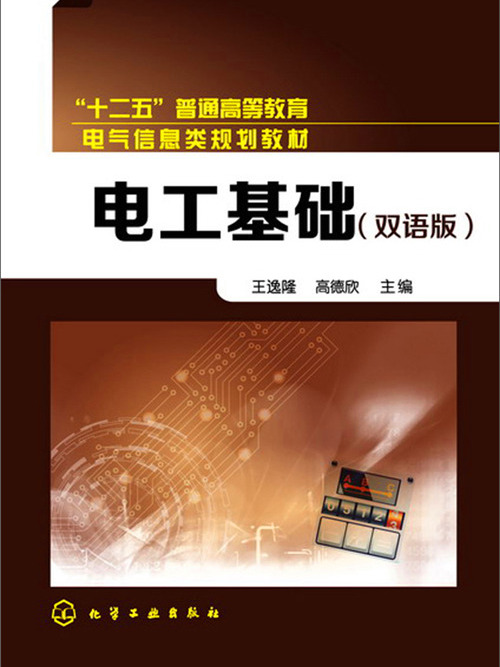內容簡介
本書從最基本的科學定律(歐姆定律、基爾霍夫定律)入手,導入了電路分析的常用分析方法和分析工具。本書首先介紹電路的基本組成及基本概念和參量,然後結合基爾霍夫定律,輔以適量例題及習題介紹
支路電流法、結點電壓法、電源模型及等效變換、疊加定理和
戴維南定理。暫態回響分析以一階電路為主,詳細分析其三種回響模式。交流電路分析以電容和電感的交流特性為基礎,分析了RLC串並聯電路的正弦穩態回響及其功率計算方法,還對三相電路原理、
三相異步電動機的原理及控制做了詳細介紹。本書注重理論與實踐相結合,採取中英文對照的方式,強化學生的專業英文能力,為後續課程學習及深造打下良好基礎。
本書可作為高等院校電子信息類、電氣類、計算機類等相關專業師生的中英文雙語教學用書,也可作為從事電子技術、電氣工程、通信工程領域的工程技術人員的參考書。
目錄
第1章電路的基本概念和基本定律1
1·1電路的組成及作用1
1·1·1電路的組成及其模型1
1·1·2電流、電壓及其參考方向2
1·1·3電位3
1·2電路的工作狀態5
1·2·1額定值與實際值5
1·2·2電路的工作狀態5
1·2·3最大功率傳輸8
1·3電路的基本元件9
1·3·1無源元件9
1·3·2獨立電源(元件)12
1·4基爾霍夫定律及套用15
1·4·3基爾霍夫定律的基本套用18
第2章電路分析的方法21
2·2結點電壓法23
2·3電阻的串並聯分析23
2·3·1等效變換的概念23
2·3·2電阻的串並聯24
2·4電源的兩種模型及其等效變換26
2·4·1電壓源模型26
2·4·2電流源模型27
2·4·3電源兩種模型之間的等效變換27
2·5疊加定理30
2·6·1戴維南定理32
2·6·2諾頓定理34
第3章電路的暫態分析37
3·1暫態過程及換路定則37
3·1·1暫態過程37
3·1·2換路定則及初始值的確定37
3·1·3一階線性微分方程40
3·2RC電路的回響41
3·2·2RC電路的零狀態回響42
3·2·3RC電路的全回響45
3·3一階線性電路暫態分析的三要素法45
3·4RL電路的回響47
3·4·2RL電路的零狀態回響48
3·4·3RL電路的全回響48
4·1正弦交流電路的基本概念51
4·1·1正弦量的三要素51
4·1·2正弦量的相量表示法53
4·2單元件的正弦交流電路55
4·2·1電阻元件的正弦交流電路55
4·2·2電感元件的正弦交流電路56
4·2·3電容元件的正弦交流電路58
4·3電路定律的相量形式60
4·4簡單正弦交流電路的分析61
4·4·1正弦交流電路的阻抗61
4·4·2正弦交流電路的功率64
4·4·3功率因數的提高65
第5章三相電路67
5·1三相電壓67
5·2負載星形連線的三相電路69
5·3負載三角形連線的三相電路72
5·4三相功率74
第6章變壓器與電動機76
6·1磁路的分析方法76
6·2變壓器77
6·2·1變壓器的工作原理78
6·2·2變壓器的運行特性80
6·2·3特殊變壓器81
6·3·1三相異步電動機的構造82
6·3·2三相異步電動機的工作原理83
6·3·3三相異步電動機的機械特性86
6·3·4三相異步電動機的運行特性88
6·3·5三相異步電動機的使用92
第7章繼電接觸器控制系統94
7·1·1刀開關和熔斷器94
7·1·2自動開關96
7·1·4熱繼電器和時間繼電器98
7·1·5按鈕和行程開關99
7·2電氣系統的基本控制環節100
7·2·1點動和長動控制100
7·2·2電動機的正反轉控制102
7·3套用舉例103
7·3·1籠型電動機能耗制動的控制
線路104
7·3·2加熱爐自動上料控制線路104
習題106
部分習題參考答案120
常見術語中英對照122
Chapter 1Basic concepts and laws of the
electronic circuit125
1·1The circuit composition and role125
1·1·1Compositions of electronic circuit
and model125
1·1·2The current、the voltage and their
reference directions126
1·1·3Electric potential128
1·2Electrical circuit operating modes130
1·2·1The rated value and the actual
value130
1·2·2The operation mode of the
circuit131
1·2·3Maximum power transmission134
1·3Basic circuit components136
1·3·1Passive components136
1·3·2Independent power supply
(components)139
1·3·3Dependent power sources141
1·4Kirchhoff′s law and applications143
1·4·1Kirchhoff′s current law
(KCL)143
1·4·2Kirchhoff′s voltage law
(KVL)145
1·4·3Basic applications of Kirchhoff′s
law146
Chapter 2The circuit analysis
methods149
2·1Branch current method149
2·2Nodevoltage method151
2·3The series connection and the parallel
connection of resistors152
2·3·1The concept of equivalent
transformation152
2·3·2The resistors series connection and
parallel connection152
2·4The power source models
and equivalent transformation155
2·4·1Voltage source model155
2·4·2Current source model156
2·4·3The power source models and
transformations156
2·5The superposition theory160
2·6The Thevenin theorem and the Nortons
theorem162
2·6·1The Thevenin theorem162
2·6·2Nortons theorem164
Chapter 3The transient state analysis168
3·1The transient process and the switching
theory168
3·1·1The transient process168
3·1·2The switching rule and the initial
value determination 169
3·1·3The first order linear differential
equation172
3·2RC circuit responses173
3·2·1The zeroinput response of the
RC circuit173
3·2·2RC circuit zero state response 175
3·2·3RC circuit complete response 177
3·3The threeelement method of the first
order linear circuit transient response
analysis178
3·4RL circuit transient response180
3·4·1RL circuit zero input response180
3·4·2RL circuit zero state response181
3·4·3RL circuit complete response181
Chapter 4The sinusoidal alternating
current(AC)circuit184
4·1Basic concepts of the sinusoidal
alternating current (AC) circuit184
4·1·1Three elements of the sinusoidal
quantity184
4·1·2The phasor representation method
of the sine function187
4·2Singlecomponent sinusoidal AC
circuit189
4·2·1The sinusoidal AC circuit for the
resistor190
4·2·2The sinusoidal AC circuit for the
inductor191
4·2·3The sinusoidal AC circuit for the
capacitor193
4·3The phasor form of the circuit
laws195
4·4The analysis of the simple sinusoidal
AC circuit196
4·4·1The impedance of the sinusoidal
AC circuit197
4·4·2Power of the sinusoidal AC
circuit199
4·4·3The enhancement of the power
factor201
Chapter 5 Threephase circuit203
5·1Three phase voltage203
5·2Threephase circuit with the star
connection load206
5·3The load triangular connection of the
threephase circuit210
5·4Threephase circuit power212
Chapter 6The transformer and
electric motor214
6·1The analysis method of the magnetic
circuit 214
6·2The transformer216
6·2·1The operation fundamental of
the transformer216
6·2·2The transformer′s operating
character220
6·2·3Special transformers221
6·3Threephase asynchronous electrical
motor222
6·3·1The structure of the threephase
asynchronous electrical motor
structure223
6·3·2The threephase asynchronous
motor fundamentals 223
6·3·3The mechanical characteristics of
the threephase asynchronous
motor227
6·3·4The operation characteristics of
the threephase asynchronous
motor229
6·3·5Threephase asynchronous motor′s
usage234
Chapter 7The relay contact device
control system237
7·1The ordinary lowvoltage control
apparatus237
7·1·1The knife switch and the fuse237
7·1·2Automatic switch239
7·1·3The AC contactor240
7·1·4Thermorelay and time relay242
7·1·5Buttons and the position
switches244
7·2Basic control units of the electrical
system245
7·2·1Point start and long dynamic
control 245
7·2·2The motor control and
reversing246
7·3Applicable instances249
7·3·1The dynamic braking control circuit
for caged type motor249
7·3·2The heat furnace automatic
material loading control circuit249
參考文獻251

